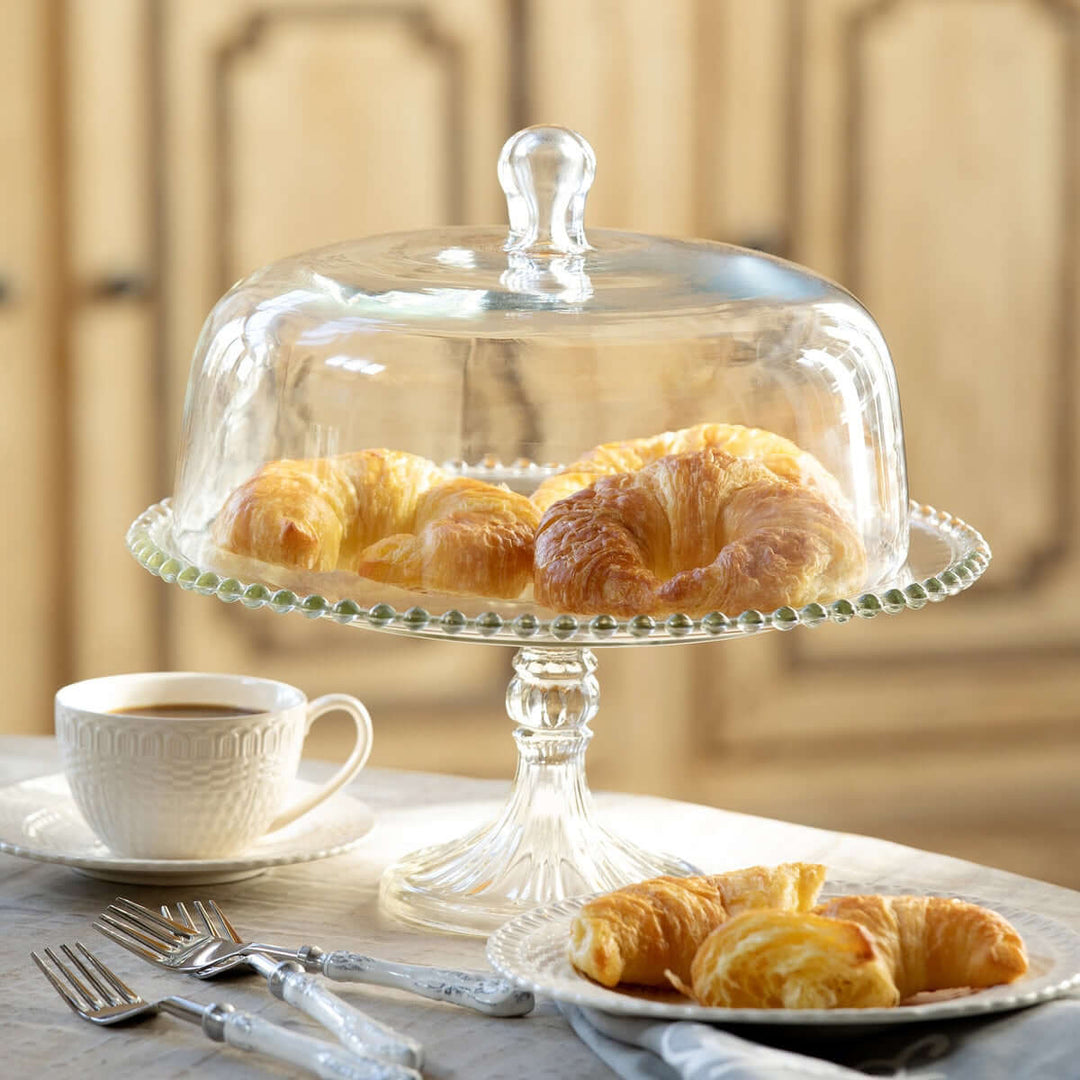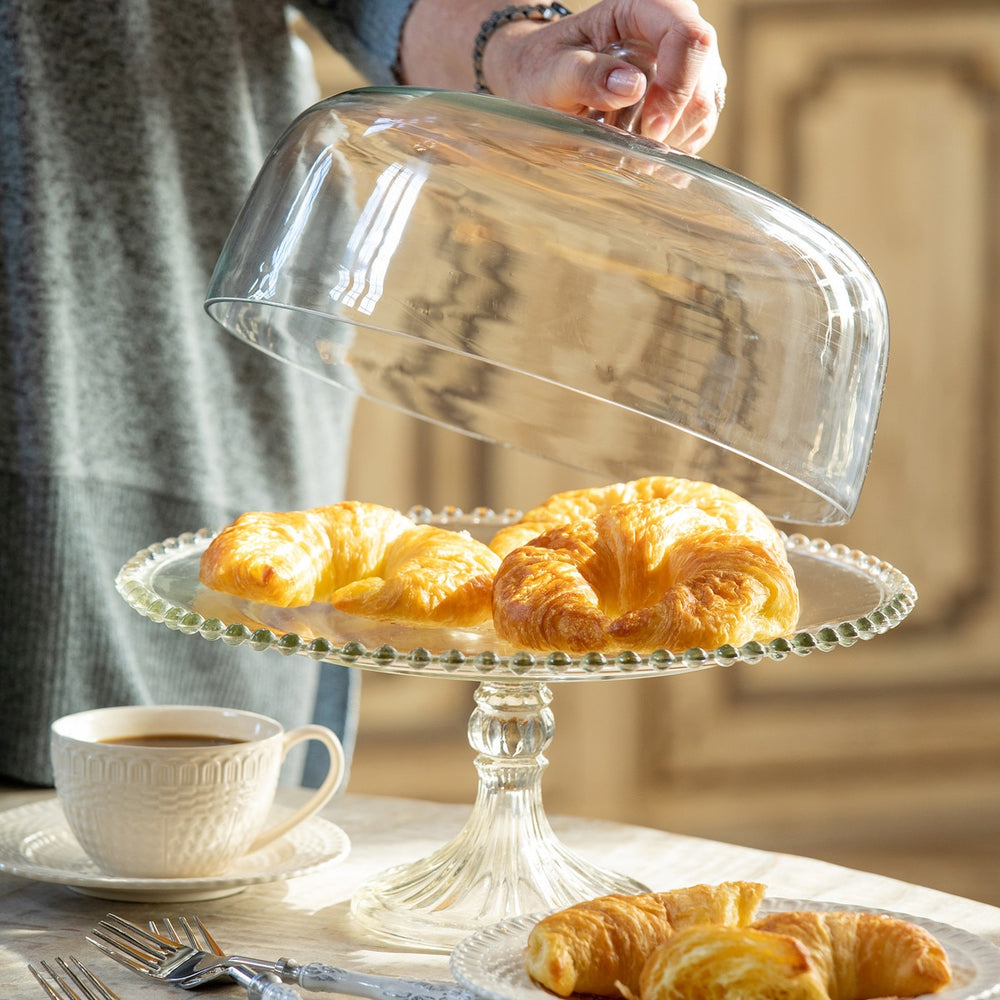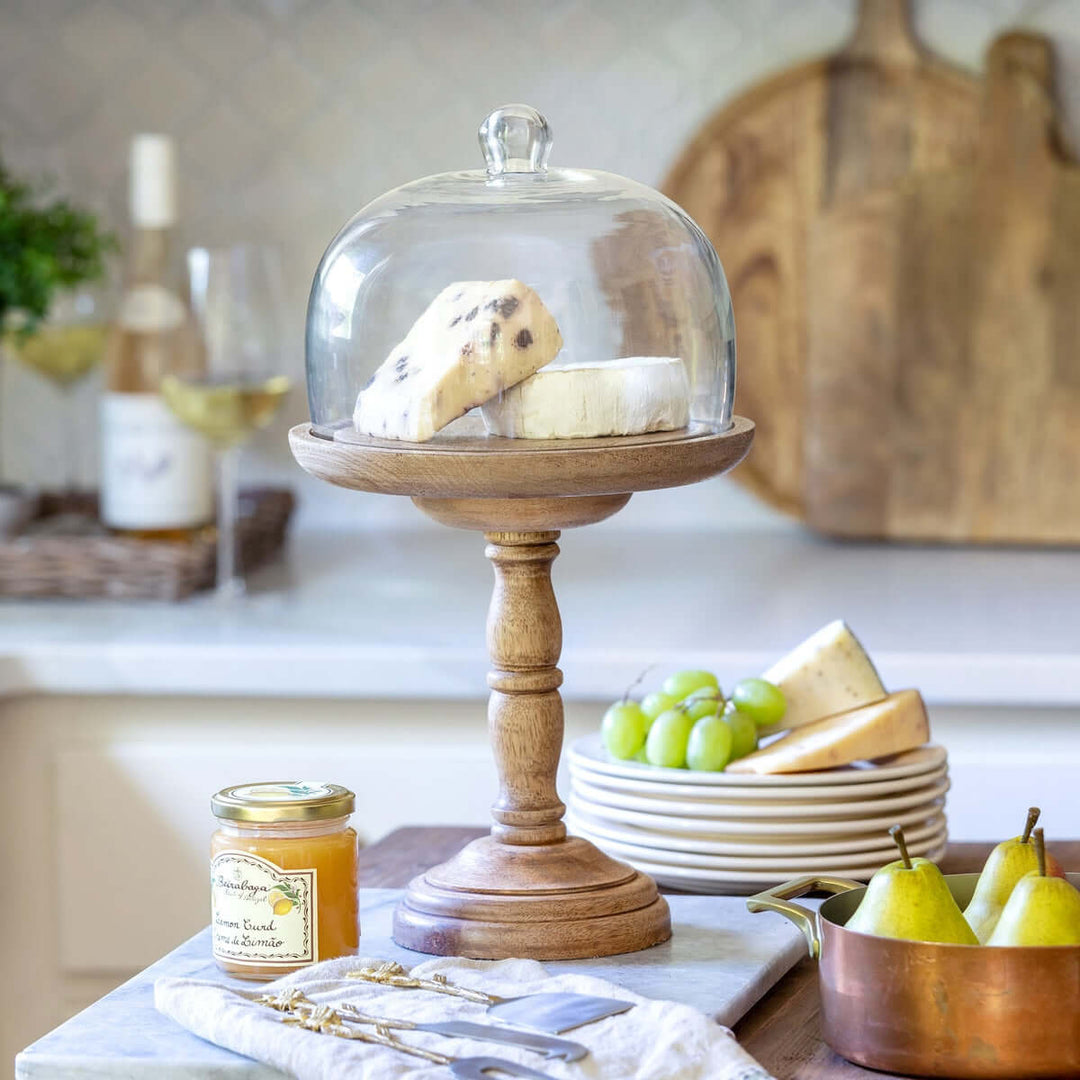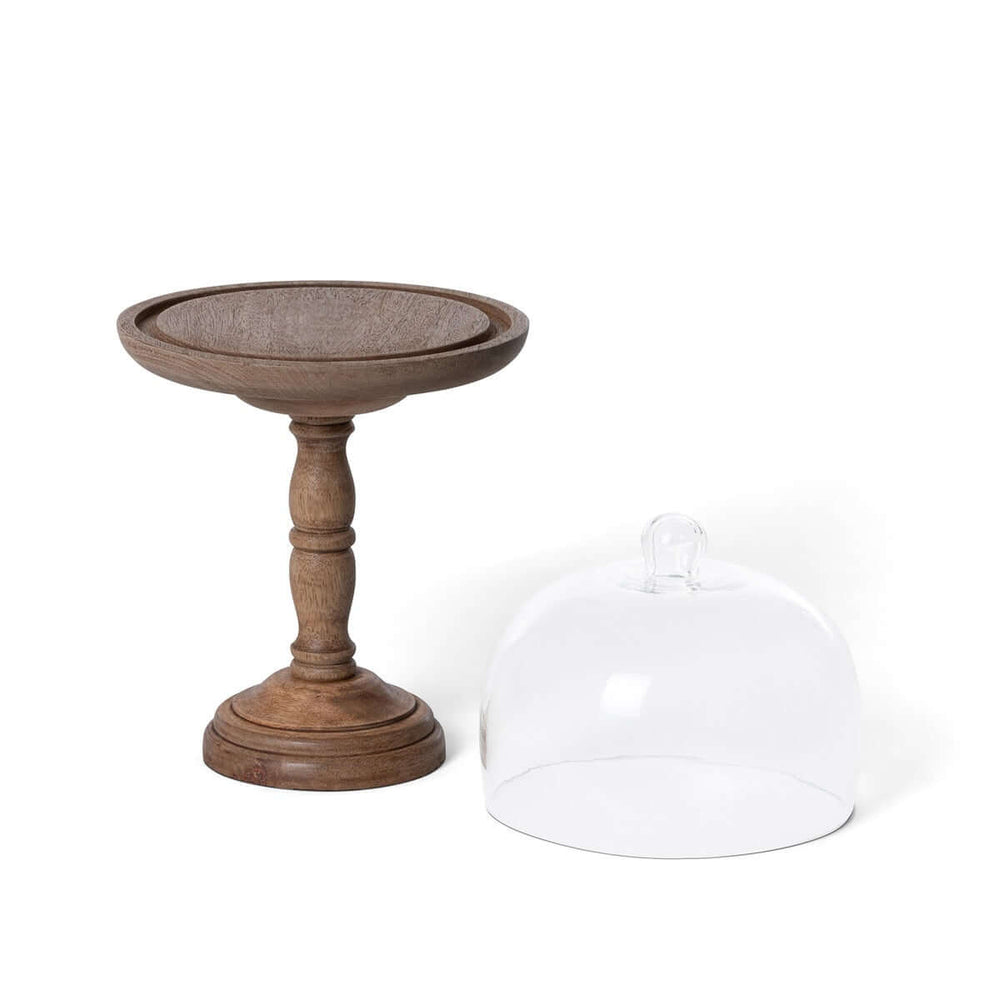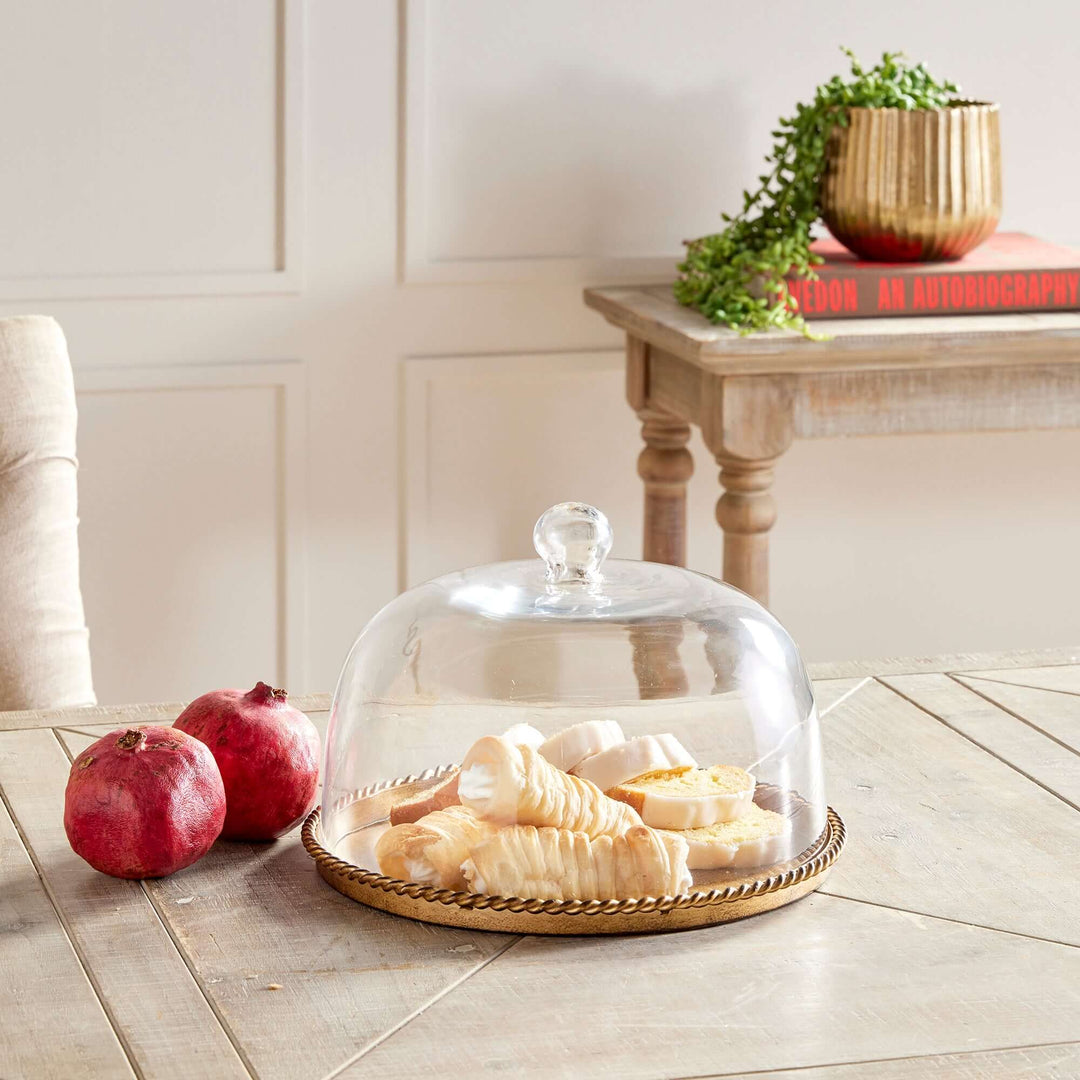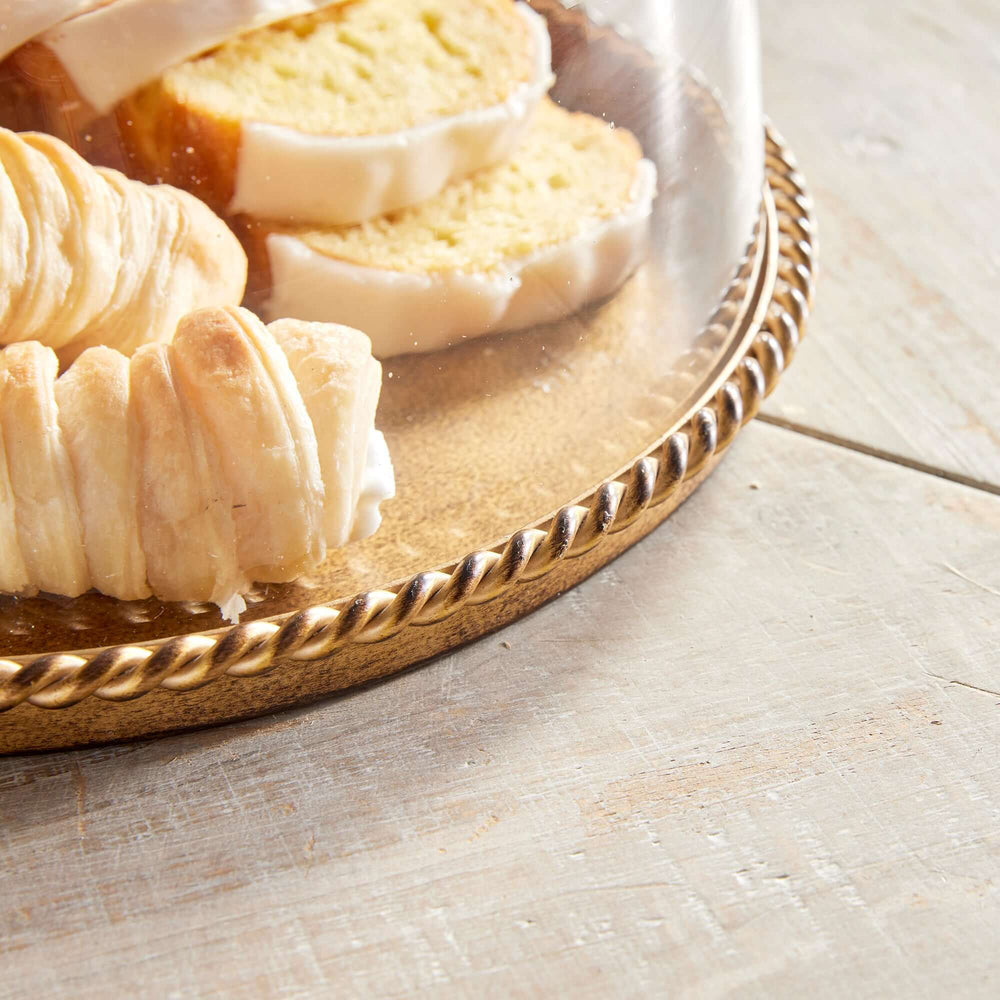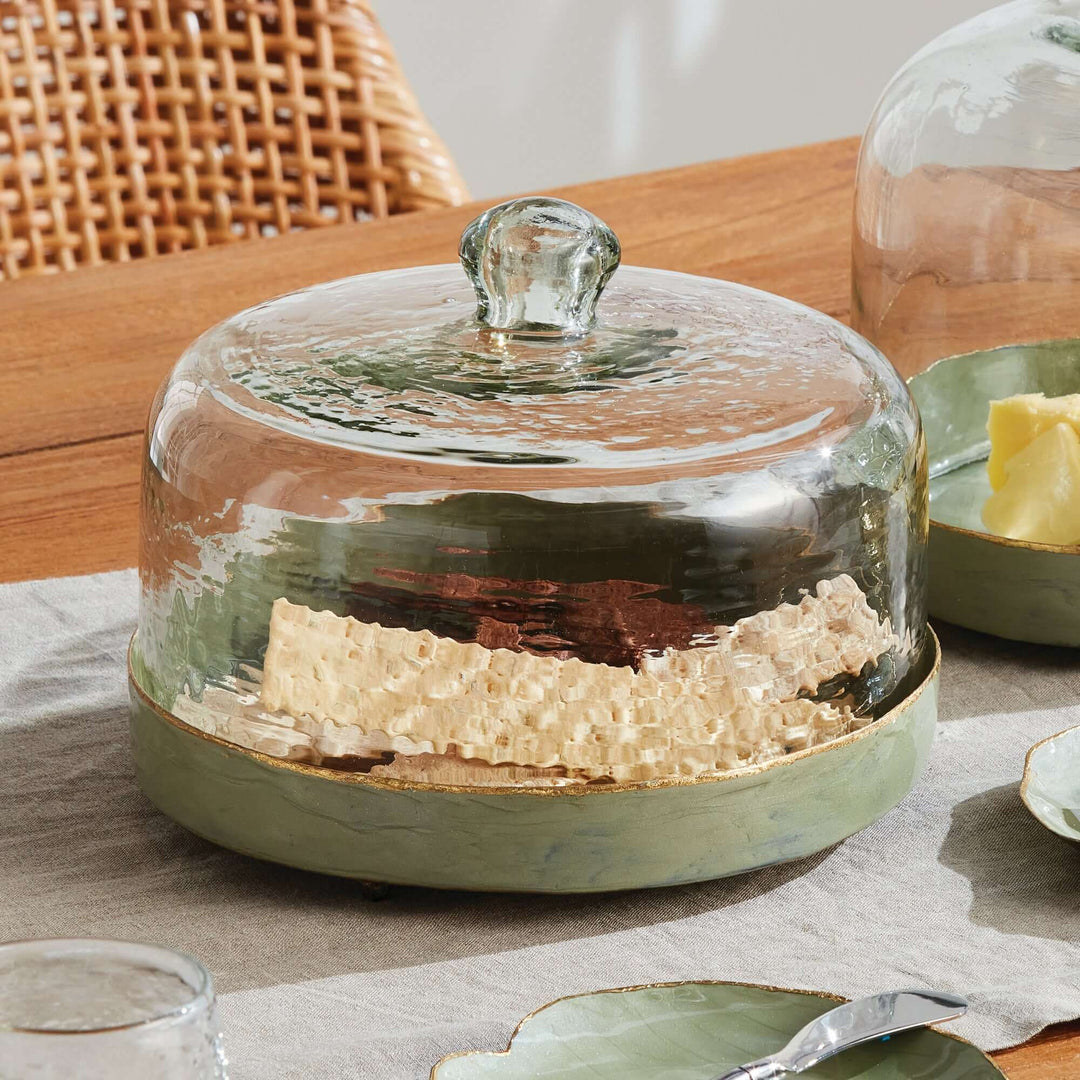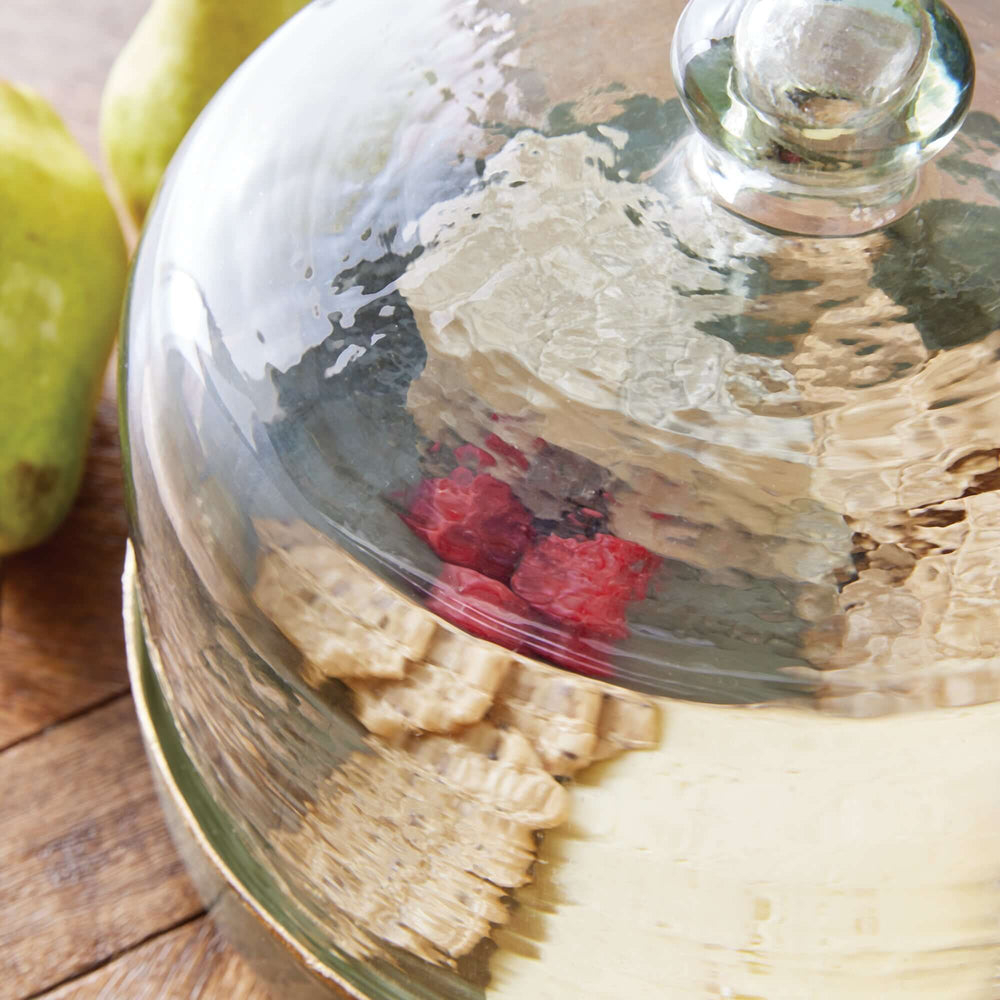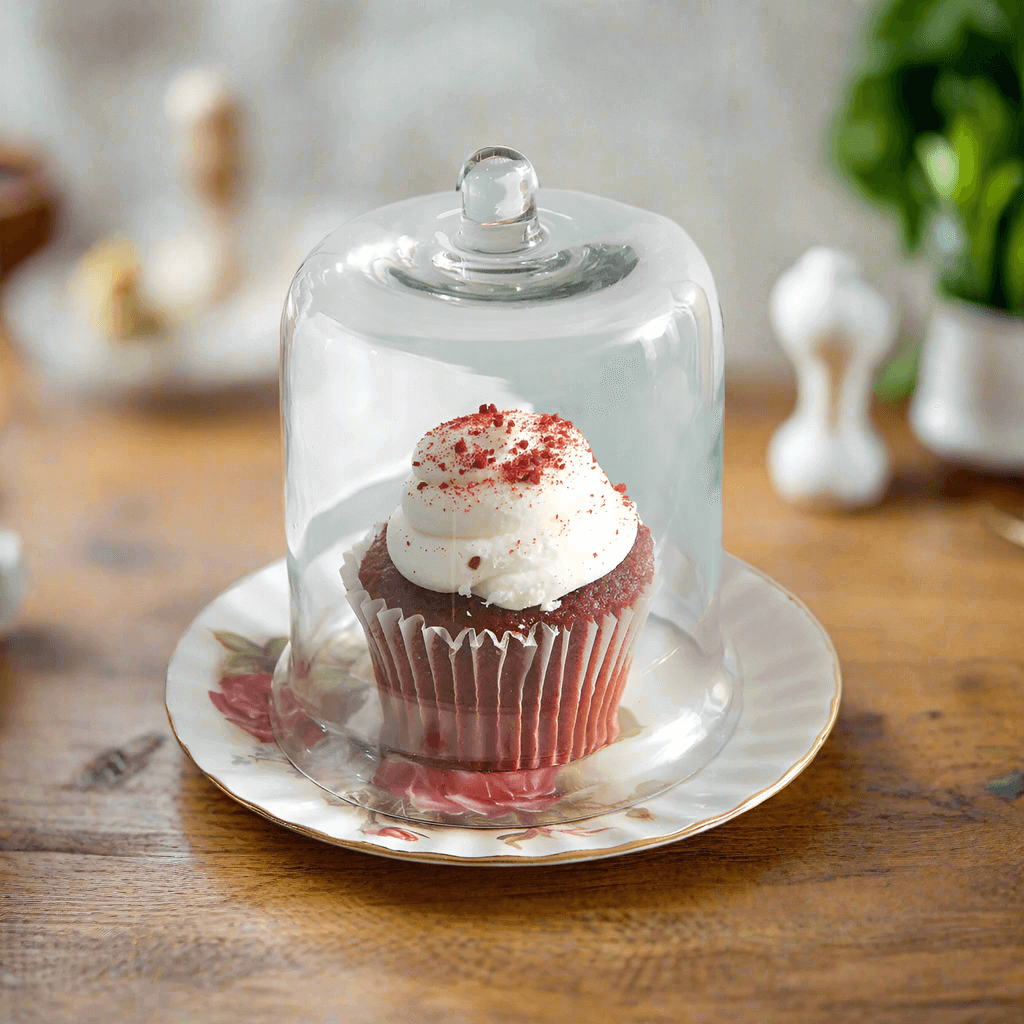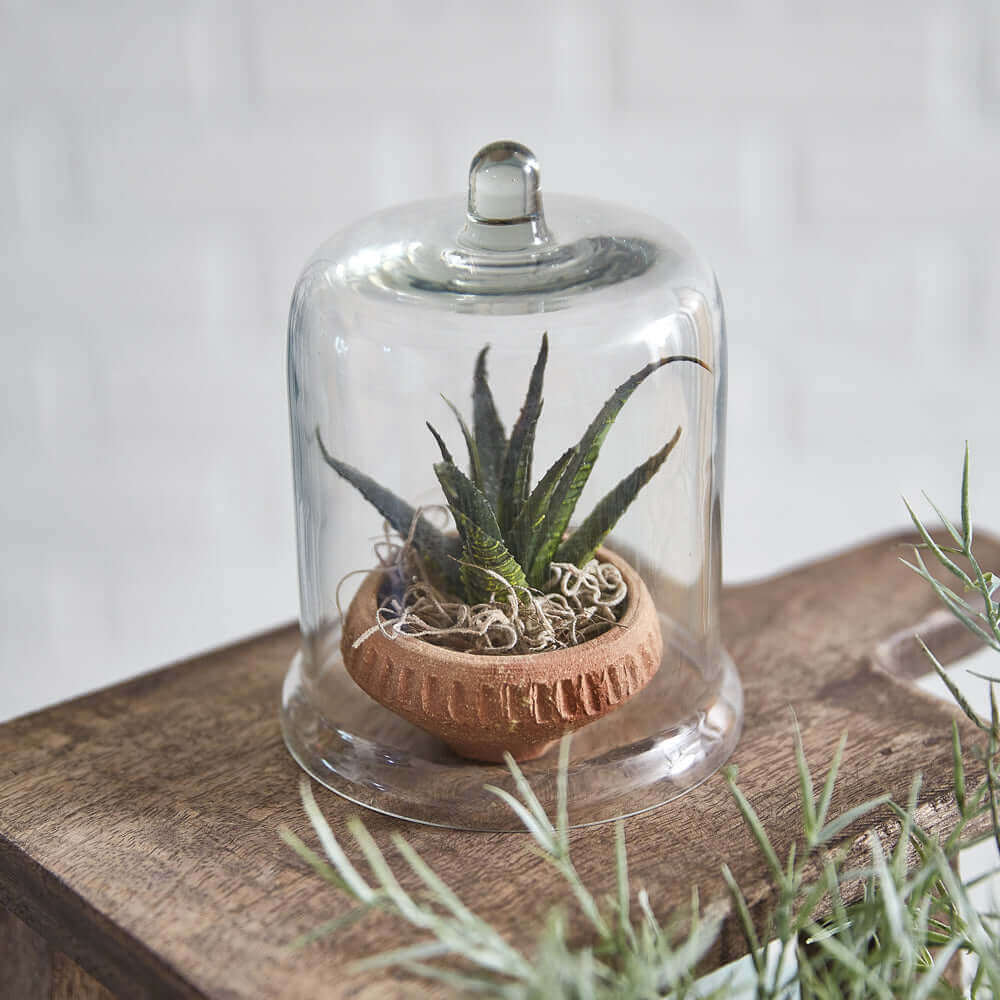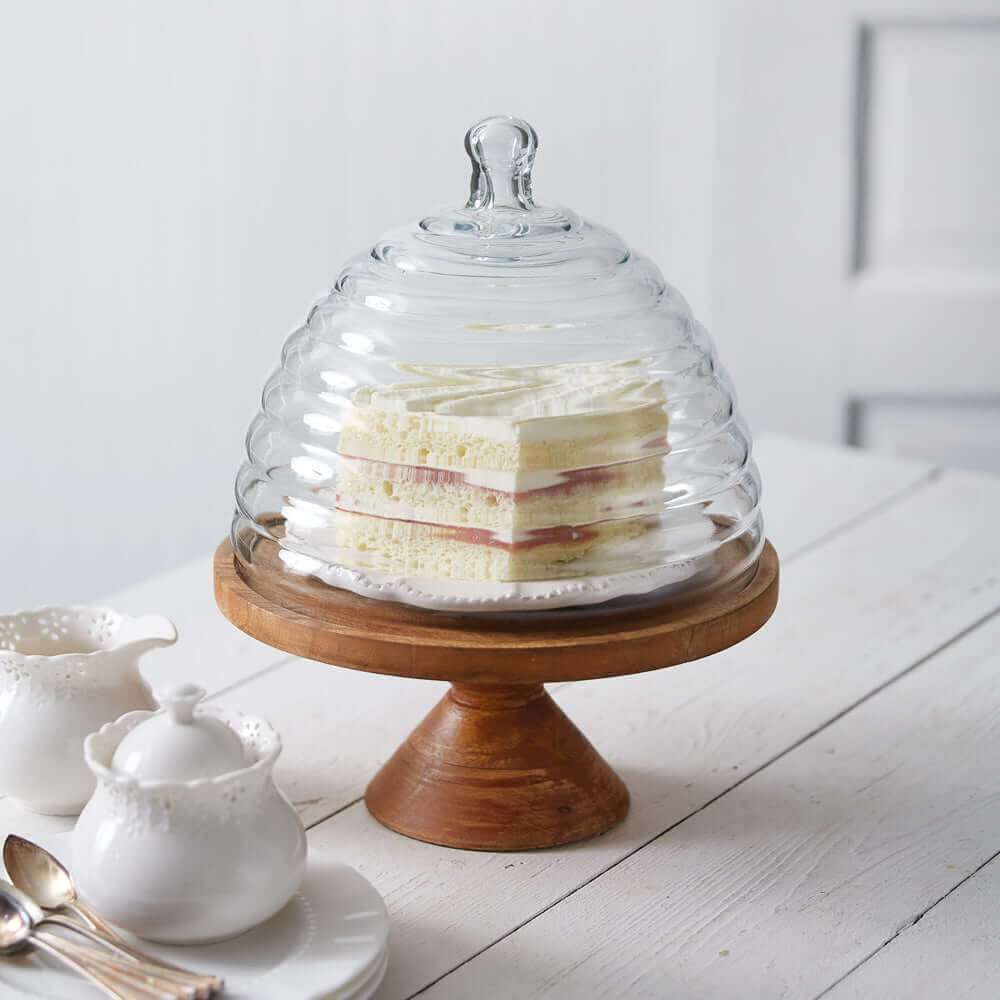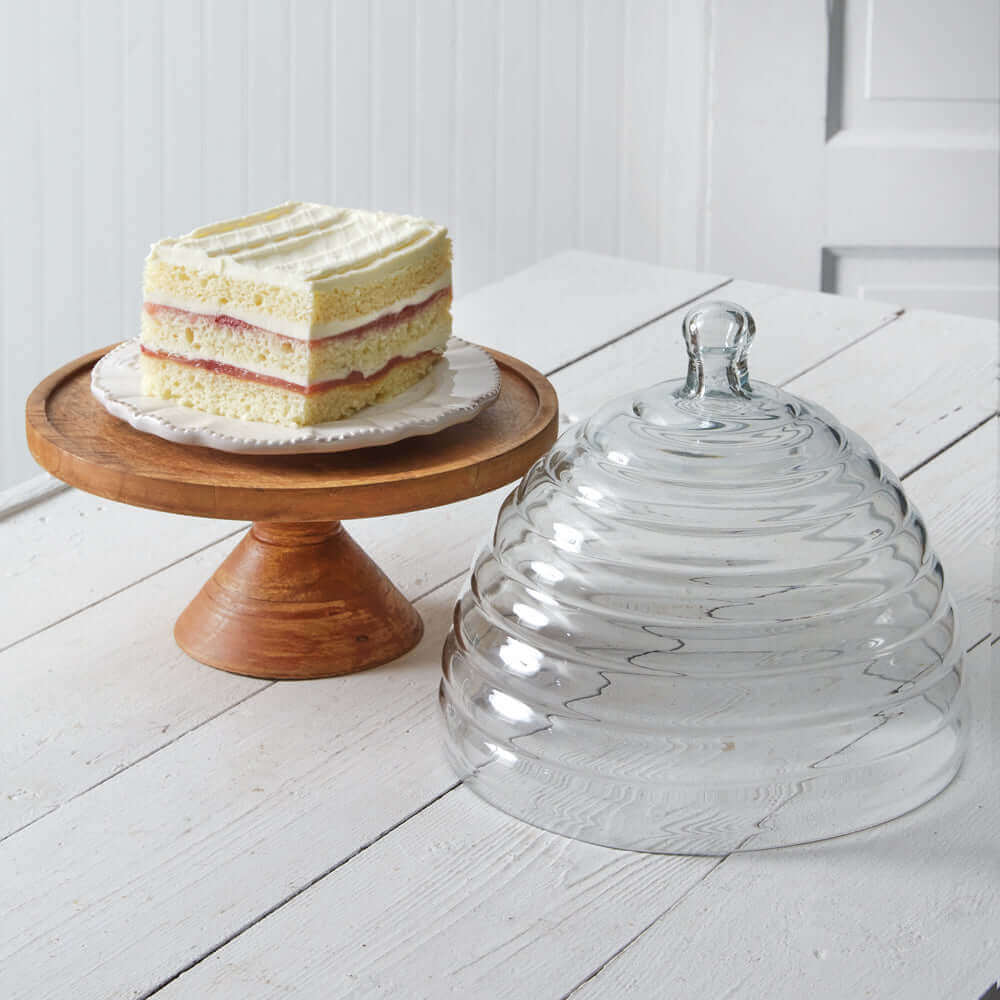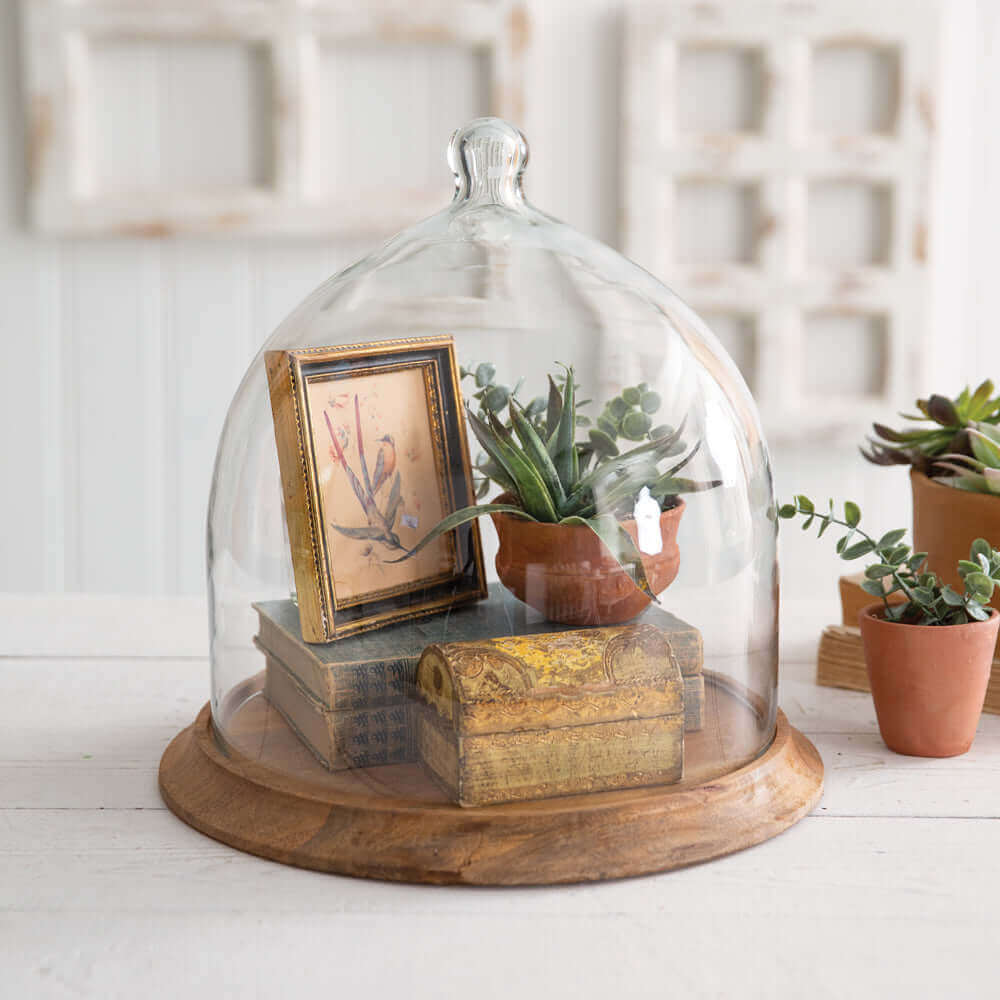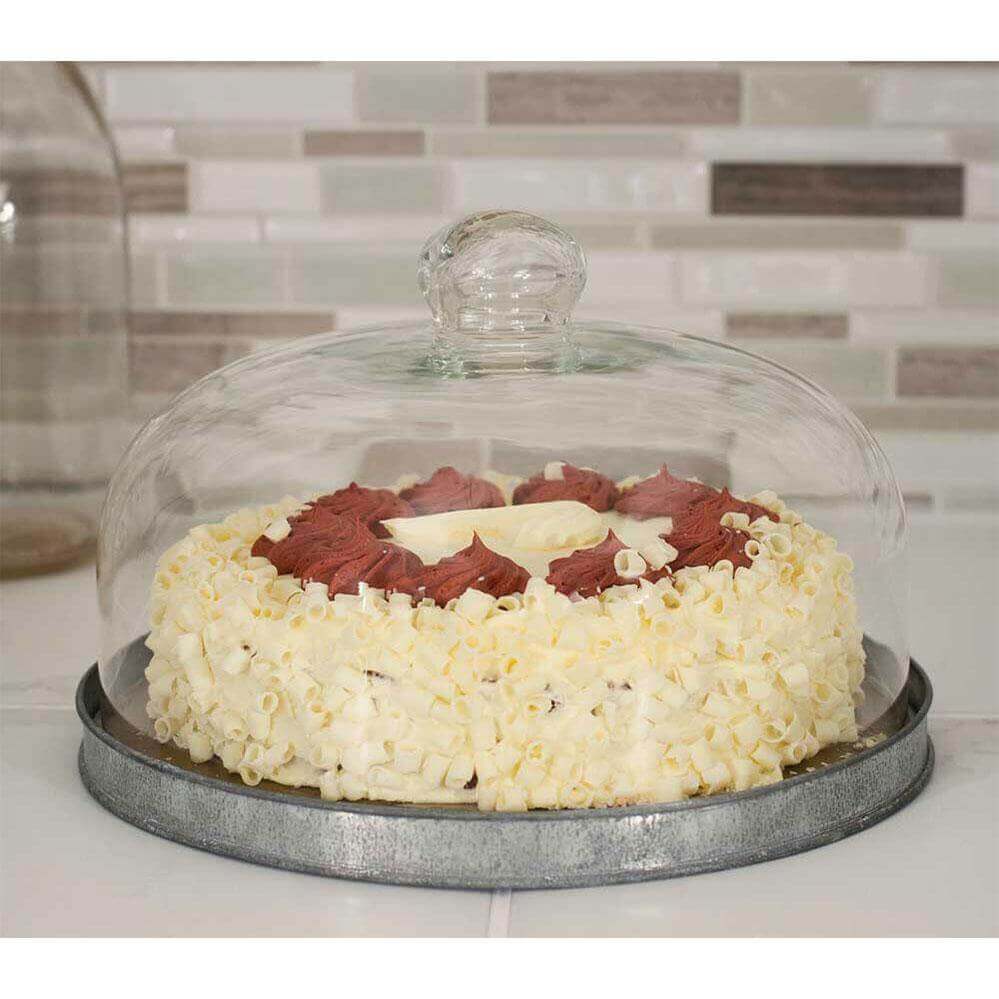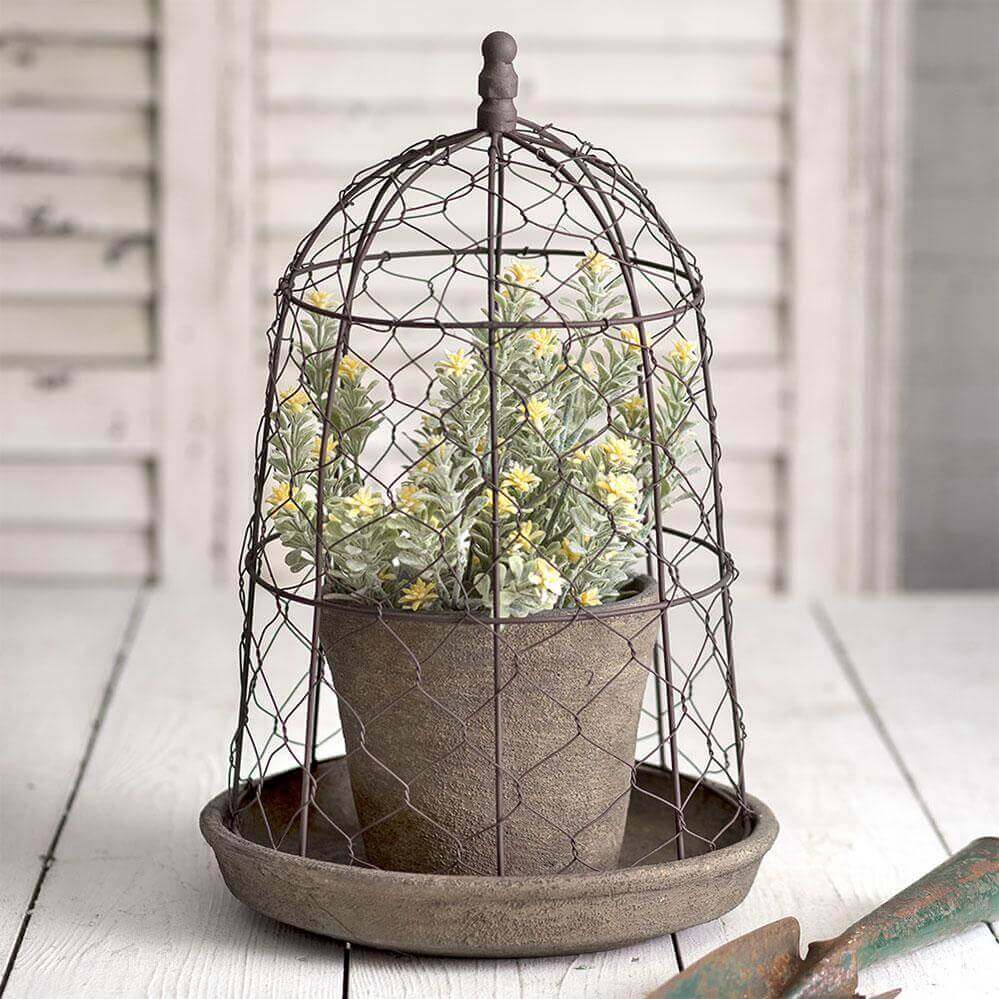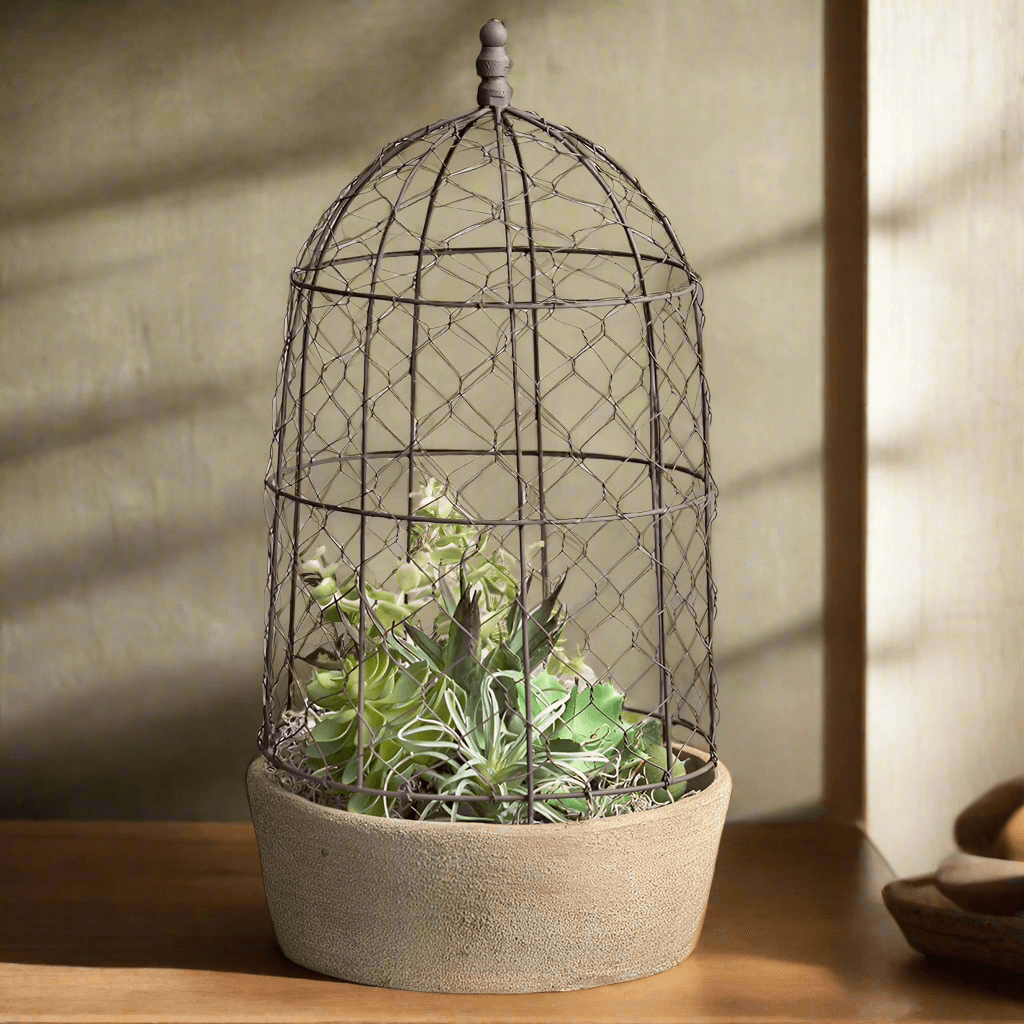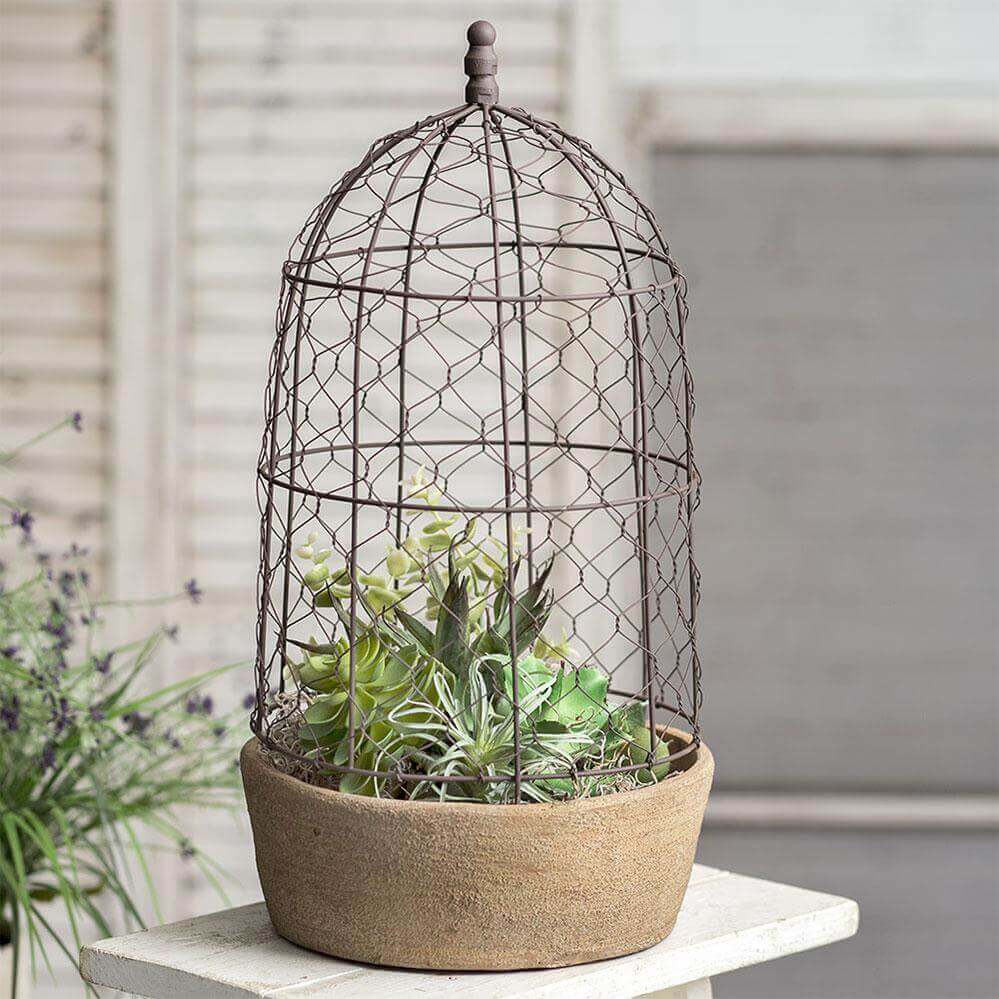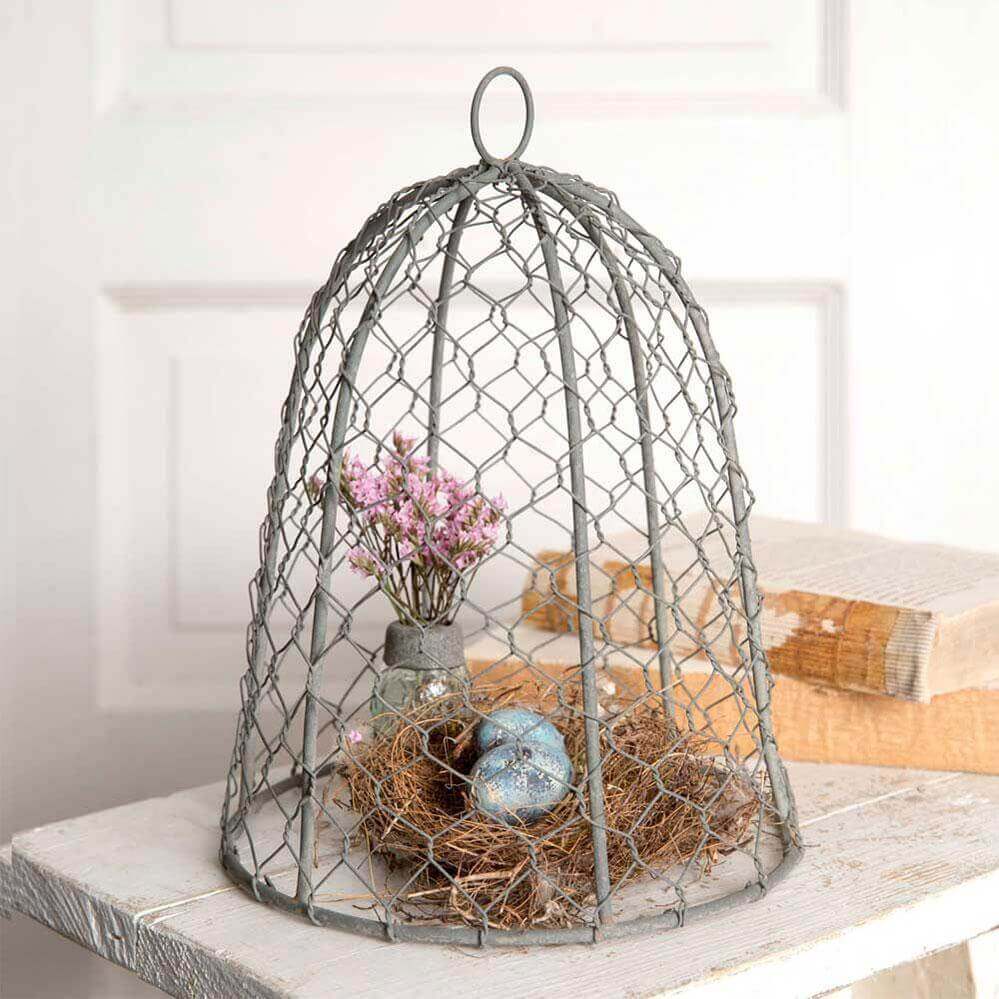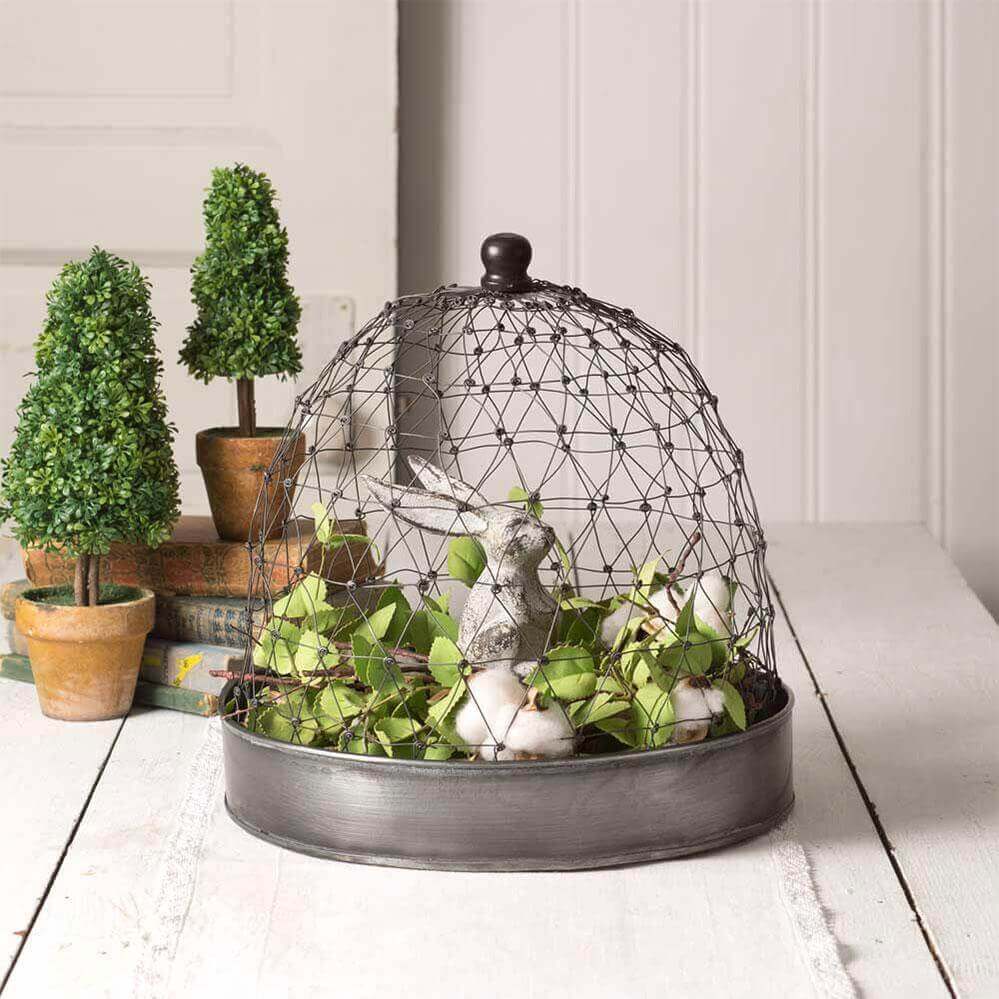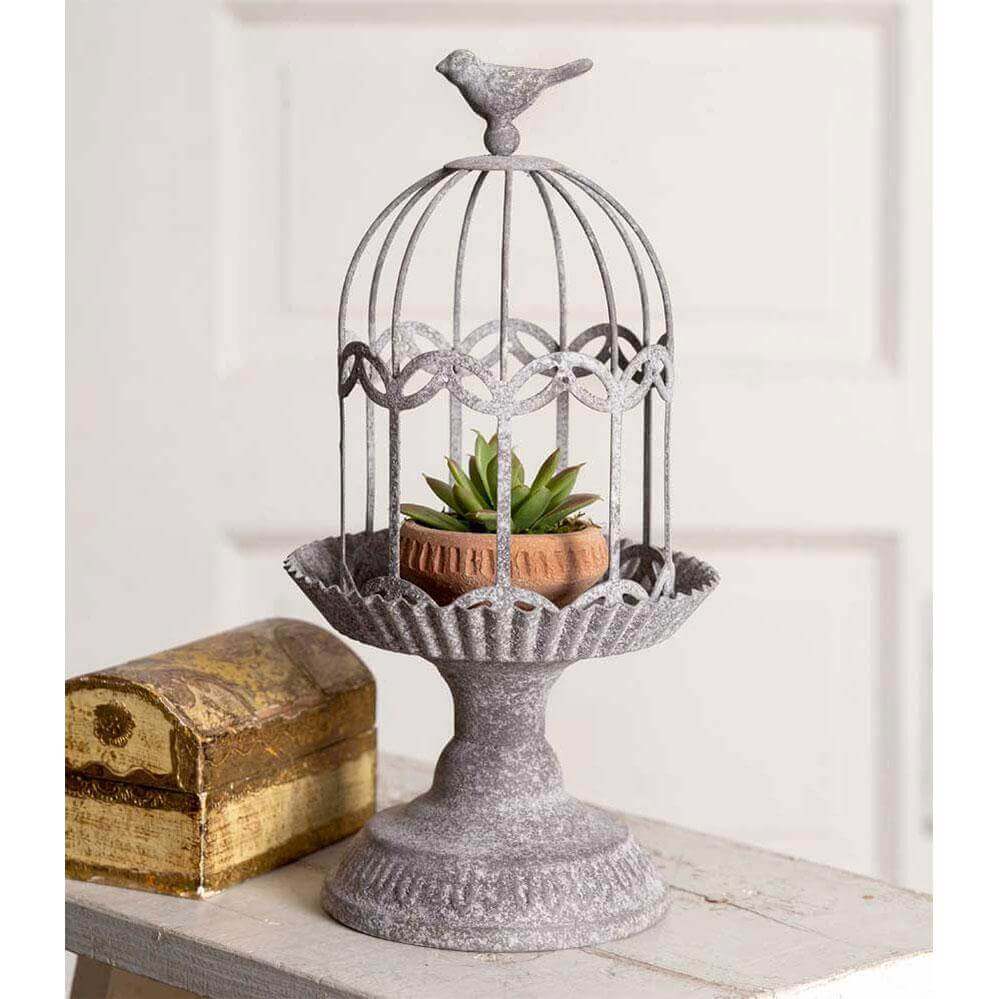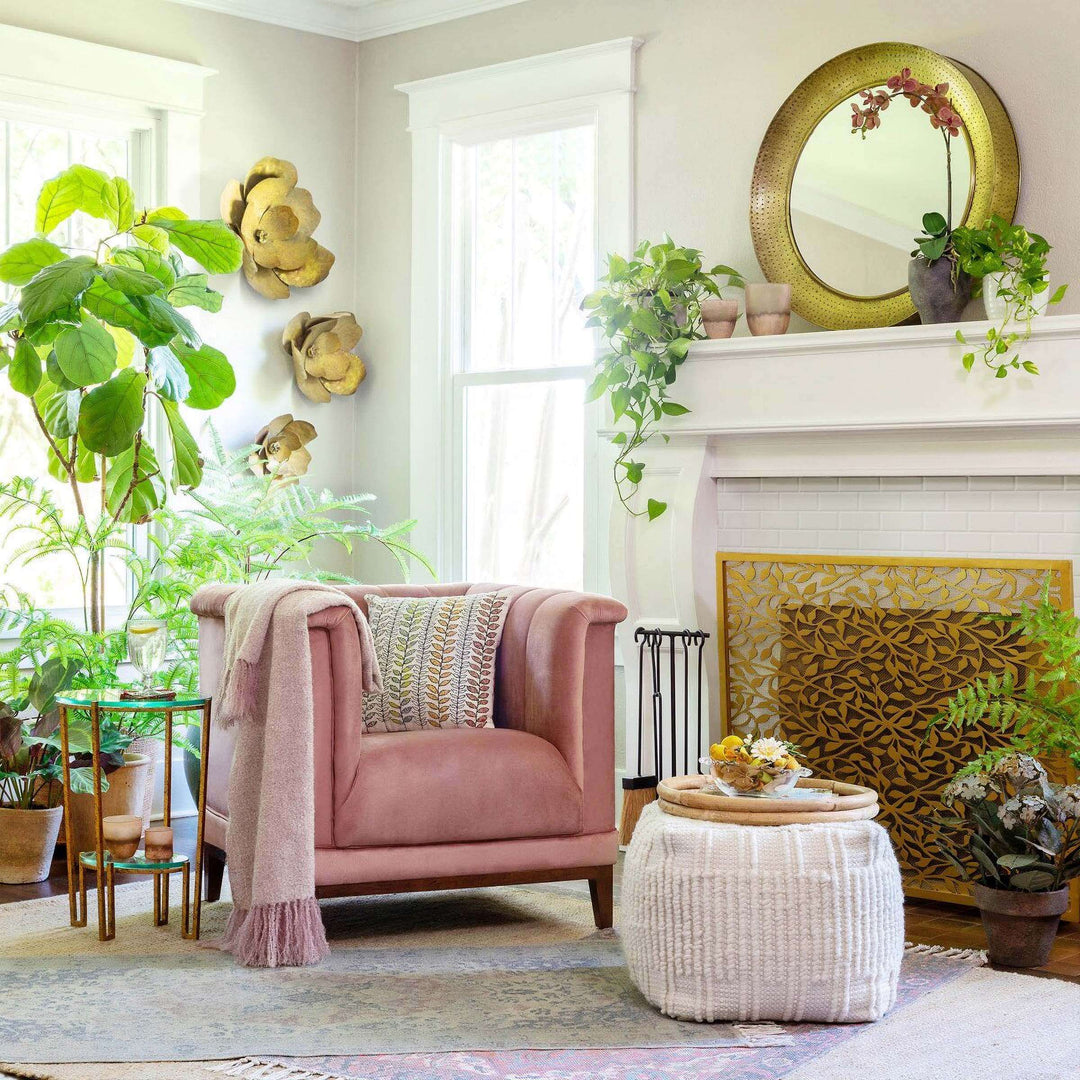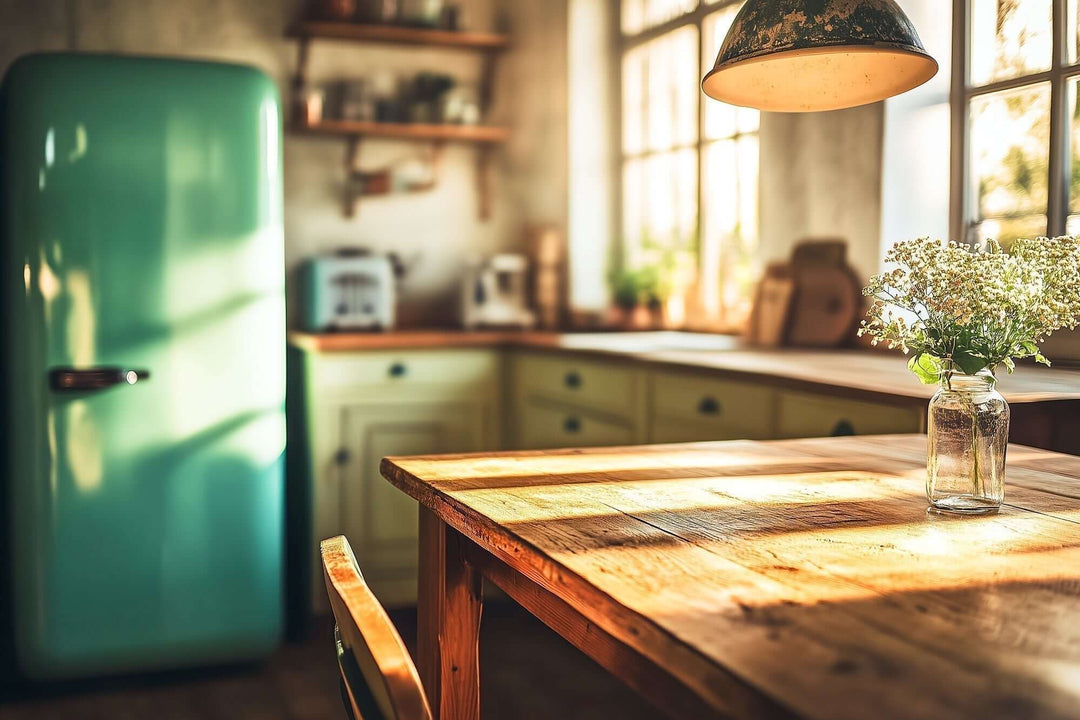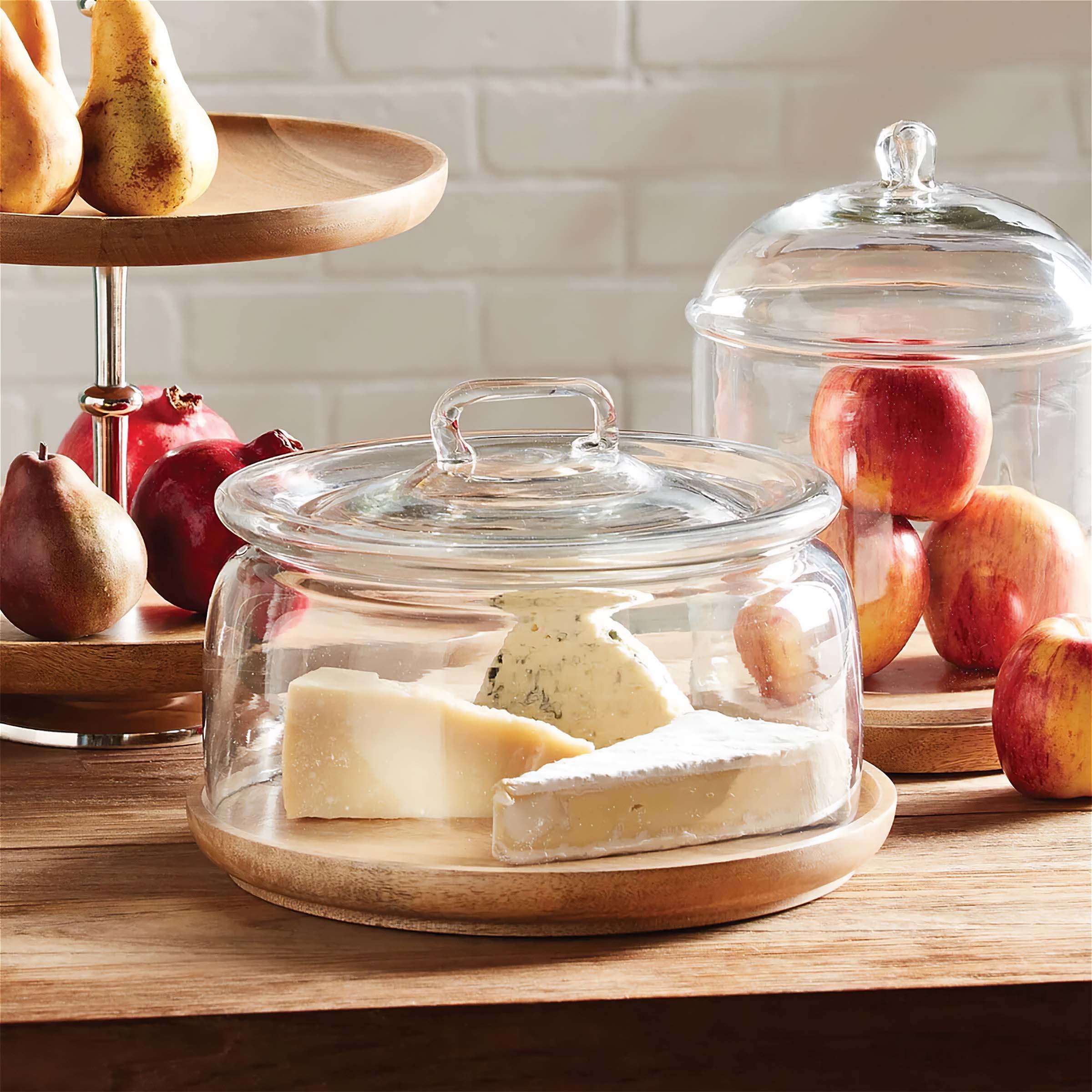
Vintage Cloches
Vintage Cloches: The Poetry of a Dome
There are few objects in the world of home décor that capture the imagination quite like the cloche. A simple dome of glass, resting gracefully upon a base of wood, marble, or metal, it is at once fragile and eternal. The word cloche comes from the French for “bell,” and indeed these domes resemble little bells of silence, poised to ring out with memory and meaning.
A cloche is more than a cover. It is a stage, a whispering chamber, a sanctum of beauty. Beneath its curve, ordinary things acquire reverence: a single rose becomes a frozen sonnet, a seashell recalls entire summers, a trinket from a grandparent’s attic becomes an heirloom sanctified. In a world that rushes, a cloche asks us to pause—to look, to savor, to honor.
The collection of vintage-inspired cloches curated by Vintage Shopper is not about antiques locked in cabinets, but about living romance: pieces designed to echo the patina of time while remaining practical, affordable, and endlessly adaptable to modern homes. They recall the Victorian parlor, the Parisian café, the country garden—and yet they thrive in today’s bedrooms, kitchens, and celebrations.
This definitive guide explores the history, styles, and enchantment of cloches. It reveals how to use them across rooms, through seasons, and as gifts that linger in memory. It is written not just to inform, but to inspire—to remind us why the glass dome continues to seduce the eye and the heart.
The History and Romance of Cloches
A French Garden’s Gift to the World
The story begins in the soil of 19th-century France. Gardeners, devoted to coaxing tender seedlings through spring frosts, turned to glass domes as guardians. Placed in neat rows across kitchen gardens, the cloches shimmered like crystal bells in the morning light, each one a sanctuary of warmth. Within their shelter, lettuces grew faster, melons ripened sooner, herbs reached higher.
There is something poetic in this origin: a tool born of necessity that looked like a jewel scattered across the earth. Even in their earliest form, cloches had an aura of magic—transparent guardians that transformed gardens into fairy-tale landscapes.
The Victorian Love Affair
The Victorians, ever hungry for curiosity and display, soon adopted the cloche into their interiors. They called them bell jars, and under their domes they enshrined the wonders of the world: taxidermy birds from far-off lands, pressed botanical specimens, wax flowers that never faded, and treasured keepsakes from family voyages.
In parlors lit by flickering oil lamps, cloches glowed like glass moons. They preserved not only objects, but stories: the seashell collected on a honeymoon, the medal earned in battle, the dried sprig of heather from a distant moor. To lift a dome was to unlock a memory, to lower it was to preserve it against the ravages of dust and time.
Edwardian Elegance and Café Culture
By the Edwardian era, cloches were no longer confined to cabinets of curiosities. They entered the kitchen and the dining room. In cafés and tearooms, cakes slumbered beneath glass domes until the precise moment of indulgence. Cheeses, glistening with ripeness, were unveiled with a flourish, releasing their aroma into the air. The ritual of lifting a cloche became part of the dining theater, turning nourishment into ceremony.
The Long Pause and the Modern Revival
The 20th century, with its appetite for modernism and utility, nearly forgot the cloche. They lingered in bakeries, in laboratories, in a few stubborn country homes—but much of their romance lay dormant. And yet, nostalgia has a way of returning. Today, cloches have found their renaissance in homes seeking warmth, personality, and narrative.
We no longer need them for seedlings or scientific specimens. But we crave them for what they symbolize: a slowing of time, a tender enclosure, a vessel that transforms simplicity into poetry.
Styles of Vintage Cloches
Glass Domes with Wooden Bases: Rustic Harmony
The marriage of clear glass and warm wood is timeless. A glass dome upon a walnut or whitewashed base feels like an heirloom even when newly made. Such cloches whisper of farmhouse kitchens where loaves of bread cooled in quiet dignity, or of apothecaries where herbs rested safely beneath glass.
When placed on a coffee table, a wooden-based cloche adds rustic gravity. On a kitchen counter, it feels as though you’ve inherited a fragment of an old-world bakery. And when styled with moss or candles, the contrast of material—transparent above, organic below—creates a vignette of harmony.
Glass Domes with Marble or Stone: Quiet Grandeur
Marble bases lend weight and permanence. They feel classical, like something a Victorian botanist might have used to exhibit a rare orchid. The veining of marble adds its own art, a natural painting beneath the dome. Jewelry, watches, or perfumes displayed on marble seem not just fashionable, but timeless.
In dining rooms, a marble-based cloche holding a cake or cheese echoes café traditions while elevating them. It is a stage upon which confections and delicacies bask in dignity until the moment of revelation.
Wire and Metal Cloches: Countryside Charm
Wire cloches tell a different story. They do not encase but embrace, protecting herbs in a sunny kitchen or candles on a garden table. Their latticework recalls French vineyards and rustic farmhouses. A wire cloche over potted lavender evokes Provence; one protecting apples on a sideboard suggests a country harvest.
Where glass feels refined, wire feels lived-in—perfect for homes that prefer warmth to perfection, charm to polish.
Pedestal Cloches with Finials: Theatrical Splendor
Some cloches rise beyond simplicity into ornament. A dome elevated on a pedestal, topped with a finial carved like a fleur-de-lis or a delicate bird, feels like something discovered at a Parisian flea market. These cloches are less about modest protection and more about celebration.
On a dining table, they elevate centerpieces into spectacles. On a mantel, they command attention. Their very shape suggests that what lies within must be special, worthy of a stage and a crown.
Seasonal Cloches: A Year of Transformations
Cloches are chameleons. At Christmas, they become miniature snow globes without water: a sprig of evergreen, a dusting of faux snow, a twinkling light. At Easter, they cradle nests of painted eggs. In autumn, they hold pumpkins, acorns, and leaves turned to amber. At Halloween, they guard curiosities—a raven figurine, a cluster of candles, a tiny pumpkin patch.
The cloche is not fixed in time; it moves with the seasons, offering a stage for whatever story the calendar is telling.
Decorating with Vintage Cloches
In the Living Room: Silent Storytellers
The living room is the stage of domestic life, and cloches make perfect actors. On a mantel, a tall cloche might shelter a candle, its glow softened into a golden haze. On a coffee table, a dome encasing a seashell or antique pocket watch invites conversation. Visitors lean closer, curious to see what you’ve chosen to treasure.
A cloche here becomes a storyteller. It does not shout; it whispers. And in that whisper lies its power.
In the Dining Room: Theater of the Table
Dining is not just eating; it is ritual, gathering, memory. Cloches elevate these moments. A row of small domes down the table, each cradling a sprig of greenery or a votive candle, creates a procession of light. A large cloche in the center holding autumnal fruit becomes not just decoration, but abundance made visible.
There is ceremony in lifting a dome to reveal what lies beneath. In Victorian parlors, it was a cake. In your home, it might be a bowl of figs or a holiday centerpiece. Either way, the act of unveiling is a performance in miniature.
In the Kitchen: Everyday Enchantment
The kitchen is the soul of the home, and cloches remind us that even utility can be beautiful. Cover a loaf of bread beneath a wooden-based dome, and suddenly breakfast feels elevated. Place a cloche over a bowl of lemons, and a humble fruit becomes a still life.
Even when empty, a cloche in a kitchen corner speaks of history—of farmhouse tables and French cafés where food was not only nourishment, but art.
In the Bedroom: Romance in Repose
Bedrooms crave softness, intimacy, a touch of the dreamlike. A cloche on a vanity, encasing a favorite perfume bottle or a piece of jewelry, turns dressing into ritual. On a nightstand, a dome filled with fairy lights becomes a moon captured in glass, glowing gently as you fall asleep.
For lovers of sentiment, a cloche can hold a ribbon, a pressed flower, a handwritten note—tokens of memory preserved not in drawers, but in sight, where they can be savored daily.
In the Garden or Patio: Returning to Roots
Outdoors, the cloche returns to its origin as a guardian of growth. In gardens, a dome shelters seedlings, recalling the French potagers of centuries past. On patios, wire cloches protect candles from the breeze or herbs from curious hands.
And yet, even outside, cloches are not just practical. They are beautiful. A glass dome filled with moss and fairy lights on a summer evening table transforms an ordinary dinner into an enchanted gathering.
Creative Display Ideas
Nature Enshrined
The cloche is the perfect vessel for the fleeting beauty of nature. In spring, place fresh blossoms inside—it is as if time has been paused, the flower forever at its peak. In summer, fill with seashells, sand, and driftwood, turning the dome into a seaside memory. In autumn, cradle pinecones and acorns, a harvest under glass. In winter, let evergreens and berries glow with candlelight.
Nature is always passing. A cloche is a way of saying: not yet.
Curiosities and Collections
Collectors know the value of display. A pocket watch, a vintage key, a tiny globe—beneath a dome, each becomes more than itself. The Victorians knew this, filling bell jars with butterflies and fossils. You can honor the same spirit with your own curiosities, whether inherited or found.
A cloche is a museum in miniature.
Holiday Tableaux
Every holiday finds a friend in the cloche. For Christmas, it becomes a snow globe: a sprig of pine, a miniature house, fairy lights glowing like hearth fires. For Halloween, it holds a crow figurine, a black candle, a whisper of cobweb. For Easter, it nests pastel eggs. For Valentine’s Day, it guards a single rose—a gesture immortalized by fairy tale.
The cloche is holiday theater, compact and luminous.
The Glow of Light
Few things are as magical as light under glass. A candle, its flame diffused, becomes soft, mysterious. Fairy lights coiled within a dome resemble fireflies, caught but still twinkling. At night, such displays feel like bottled starlight—an enchantment in plain sight.
Gifting with Cloches
For Gardeners
A small dome with moss or succulents becomes a terrarium, a living gift that speaks of patience and care. It is both practical and poetic—a nod to the cloche’s horticultural origins.
For Romantics
Few gestures are as moving as presenting a keepsake beneath a cloche. A piece of jewelry, a preserved flower, a handwritten letter—all become sacred when framed in glass. For Valentine’s Day or an anniversary, a rose under a dome says what words cannot: love preserved, love cherished, love eternal.
For Holidays
At Christmas, a cloche holding ornaments becomes a gift that decorates and endures. At Easter, a nest of painted eggs under glass is a keepsake of spring. At autumn gatherings, a cloche filled with miniature pumpkins makes a host’s table both festive and timeless.
For Hosts and Hostesses
Instead of a bottle of wine, arrive with a cloche bearing artisanal cheese, pastries, or a small bouquet. It is both a treat and a keepsake. Long after the food is gone, the dome remains—a gift that continues to serve beauty.
Choosing the Right Vintage Cloche
Size and Scale
A small cloche is intimate, perfect for jewelry, candles, or place settings. A medium cloche becomes versatile—a centerpiece, a food cover, a seasonal display. A large cloche is dramatic, transforming an object into a focal point that commands the room.
Always let the object breathe within the dome. Too small, and the cloche feels crowded; too large, and the object feels lost. The right proportion creates harmony.
Materials and Finishes
The material of the base tells its own story. Wood is rustic, warm, welcoming. Marble is luxurious, cool, timeless. Metal is rustic or industrial, depending on finish. Glass can be clear, for crispness, or seeded, for antique charm.
Choose what matches your home’s character.
Matching Style to Décor
-
For farmhouse kitchens, wooden bases and wire cloches feel most at home.
-
For romantic bedrooms, marble and seeded glass suit the softness.
-
For industrial lofts, metal cloches harmonize with raw brick and steel.
-
For Victorian-inspired interiors, pedestal cloches with finials are essential.
Quality Considerations
Seek clarity in glass, stability in base, harmony in proportion. A cloche should not wobble or distort. Its dome should be smooth, its base well-finished. The details matter; they transform a piece from ordinary to heirloom.
Care and Maintenance
Glass Domes
Keep glass polished, free of streaks and dust. Use gentle cloths, soft motions. The dome is a lens; clarity is its essence.
Wooden Bases
Wood must be nourished. Wipe gently, oil occasionally, keep from excessive moisture. With care, wood bases will grow more beautiful with age, their patina deepening like leather or wine.
Marble and Stone
Stone is durable, but delicate to acids. Avoid harsh cleaners. Wipe with softness, admire the veining, let it tell its quiet story.
Wire and Metal
Dust with care, avoid rust through gentle drying, cherish the patina. Metal carries history in every shade and scratch.
Storing with Respect
Never stack domes directly; they are fragile as bubbles. Store upright, cushioned. Treat them not as objects, but as companions in beauty.
The Eternal Allure of Cloches
The cloche is a paradox: fragile, yet enduring; simple, yet profound. Born in gardens, raised in parlors, celebrated in cafés, it now graces our homes with old-world charm. It does not shout for attention; it creates silence, a hush around beauty.
In your living room, it becomes a storyteller. In your dining room, a stage. In your kitchen, a reminder that food is art. In your bedroom, a vessel for romance. In your garden, a return to roots.
The cloche has survived centuries because it speaks to something eternal in us: the desire to protect, to display, to savor, to slow down. It makes us see again what we might overlook.
Explore Vintage Shopper’s Vintage Cloches Collection and bring this timeless romance into your own home. Beneath the dome, your stories await.
FAQ: Vintage-Inspired & Antique-Style Cloches
A cloche, also known as a bell jar or glass dome, is a protective cover traditionally used in kitchens, gardens, or parlors. Today, cloches are beloved as decorative domes for food, plants, and home décor.
Vintage cloches are authentic antiques, often fragile and costly. Vintage-inspired or antique-style cloches are modern reproductions designed with the same historic charm but built for everyday use.
Modern decorative cloches are used to display candles, flowers, collectibles, jewelry, and seasonal décor. They are also popular for weddings, dinner parties, and food presentation.
Yes. Farmhouse cloche décor is perfect for covering cakes, pastries, cheeses, or fruits, adding rustic charm while keeping food fresh.
Most vintage-inspired cloches are food-safe and designed to cover baked goods or cheese boards. Always check product details before direct food contact.
Fill cloches with candles, dried flowers, shells, books, or ornaments. Victorian glass domes look stunning in living rooms, bedrooms, and entryways, while rustic cloches suit farmhouse kitchens.
Yes. Cloches are popular for wedding centerpieces, especially when filled with candles, roses, or keepsakes, creating a romantic vintage-inspired look.
Some glass garden cloches protect seedlings outdoors, but most decorative cloches are designed for indoor displays.
They range from mini cloches for jewelry or desserts, to oversized display domes for cakes, floral arrangements, or statement centerpieces.
Most feature clear glass domes with bases of wood, iron, or ceramic. Some have distressed finishes to mimic authentic antiques.
Clean glass domes with a soft cloth and gentle cleaner. Dust or lightly oil wooden bases, and polish metal bases with appropriate products.
No. Antique-style cloches are far more affordable than true antiques, offering elegance without high cost or fragility.
Yes. Decorative cloches make beautiful candle displays, especially with LED candles or fairy lights. For real candles, allow ventilation to prevent overheating.
- Spring: Flowers, nests, or Easter eggs.
- Summer: Seashells, driftwood, or herbs.
- Autumn: Pumpkins, acorns, and amber leaves.
- Winter: Ornaments, fairy lights, or tiny villages under Victorian glass domes.
Cloches complement farmhouse, French country, shabby chic, Victorian, industrial, and eclectic interiors. Farmhouse cloche décor is especially popular on rustic kitchen tables.
Yes. A vintage-style cloche is symbolic of protection and beauty, making it a thoughtful gift for weddings, housewarmings, anniversaries, or holidays.
While made of glass, modern vintage-inspired cloches are sturdy and durable enough for daily use, unlike delicate antiques.
Yes. Many people use display domes to house mini-gardens with moss, succulents, or preserved plants.
Cloches and cake stands both showcase food, but cloches are more versatile — they cover not only cakes but also décor, candles, and collectibles.
True antiques can be fragile, costly, and impractical. Vintage-inspired cloches provide the same aesthetic with modern durability and affordability.
Yes. Grouping cloches of different sizes creates a layered, eye-catching vignette, especially on mantels, dining tables, or sideboards.
While most are bell-shaped, some antique-style glass domes are oval or cylindrical, offering variety in display styles.
Use cloches to highlight ornaments at Christmas, eggs at Easter, patriotic displays for Independence Day, or spooky décor at Halloween.
Yes. In contemporary interiors, a single decorative cloche can act as a striking focal point, adding warmth and contrast to clean, modern spaces.
While not true antiques, vintage-style cloches often become sentimental keepsakes thanks to their timeless design and emotional meaning.




